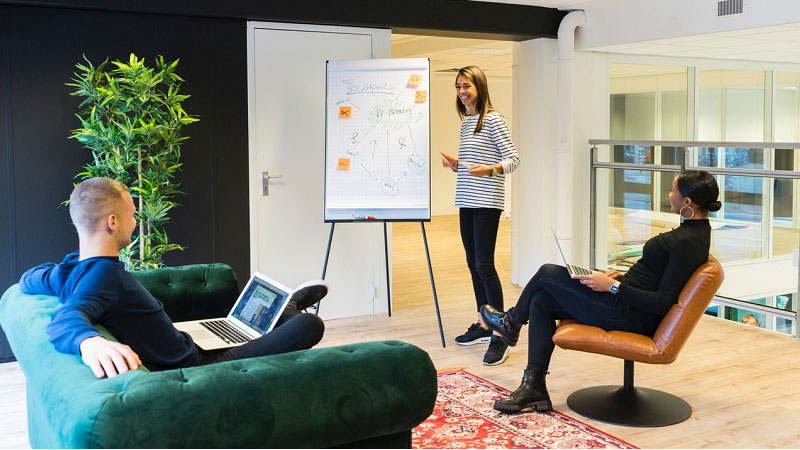The traditional office layout and workplace cubicle design that’s been the norm for decades is quickly coming to an end as the future of work now looks significantly different than just a few years ago. Companies spanning every industry have had to adapt to the sudden shift to remote work at the onset of the COVID-19 pandemic and cope with the past two years of change and uncertainty. Now that many companies are returning to work, what the future of work looks like—and what employees expect—has changed, with many employees desiring more flexible work arrangements and the ability to work remotely at least some of the time. As a result, there has been a rapid transformation in workplace design to accommodate the fast-paced changes and evolving needs of today’s modern workforce.
This is because the office is no longer just a workplace.
The latest trends in workplace design aim to blend the functional and beautiful in new and exciting ways. This can help to improve employee engagement and productivity by optimizing focus, efficiency, and collaboration. Not only does a great office design influence how clients and employees perceive an organization, but it can also help transform several business operations.
An ineffective workplace design can negatively impact both the employee experience/performance and business revenues. For instance, this case study of a large European bank found that poor office layout was impacting collaboration.
Analysis of office layout data from two of its branches (one high-performing and one low-performing branch) showed that poor office design was restricting communication patterns and limiting opportunities for collaboration throughout the day in the low-performing branch.
To better understand the importance of workplace design, let’s take a look at several benefits that organizations enjoy when a good office design is implemented.
Improves Employee Recruitment and Retention Rates
In recent years, demand for talent has far outstripped supply.
It’s imperative for employers to understand their workforce’s needs, desires, and expectations. Only by having a deep understanding of the workforce can employers design spaces that address employees’ needs, support collaboration and productivity, and entice employees to come to the physical office in the post-pandemic era. Employees have grown accustomed to remote and hybrid work arrangements and may prefer to continue working remotely some or all of the time. By designing effective and collaborative workspaces, companies can make it appealing for employees to return to the physical office.
To stay ahead, savvy employers are leveraging intuitive workplace design to help retain employees and recruit top talent. This is due to the impact of physical surroundings on mood, comfort, focus, and productivity. The design and structure of the workplace can affect the personal effectiveness of workers and make them feel more valued.
Also, employees are more likely to remain at an organization if they’re comfortable with the layout and ergonomics of the workspace. As a result, when it comes to attracting and keeping top talent, businesses with appealing office designs and sufficient flexibility in scheduling have an edge over the competition.
Ensures a Future Proof Workspace
Traditional office space was designed to be immovable, but many modern organizations have moved toward a more flexible design to accommodate the new way of working, with some employees working remotely, others working on-site, and some adopting a hybrid approach. In the post-pandemic era, the widespread adoption of these new ways of working affects work styles, and employees who are returning to the physical office need to have an improved experience.
A flexible, collaborative design encourages communication and collaboration, reducing the likelihood that employees arrive at the office only to spend their days on Zoom calls without much face-to-face interaction with coworkers on-site. This typically features a modular, adaptable workspace that can be easily modified, allowing the office to evolve in line with both company and project needs as well as employee preferences. Such a workplace design helps to reduce costs and maximize real estate footprint by being responsive to current and future needs.
Advancements in technology and the nature of the global economy have made it difficult to predict the job functions that a business might need in the future. A good office design considers and incorporates the future needs of the organization, thus efficiently utilizing corporate real estate expenditure to support teamwork, flexibility, and creativity.
Appeals to Millenials and Gen Z Workers
Some Millennials and Gen-Z employees prefer to work remotely most of the time in the post-pandemic era, although others are craving interaction time and collaboration opportunities. For employees that thrive in collaborative, team-based environments, simply having a physical office space from where employees remain isolated in Zoom calls all day falls short of meeting their needs. A great office design makes it easier for organizations to integrate new technology to support remote and hybrid work while also providing spaces that support effective collaboration to meet the needs of those who desire more in-person interactions.
Younger employees thrive in collaborative, social environments and are more productive in dynamic, blended workspaces that feature a mix of open, semi-private, and private offices. Incorporating casual seating groups, unenclosed breakout areas, meeting/huddle rooms, common areas, and unassigned workstation seating into such blended workspaces can do wonders for employee engagement and productivity.
Enhances Cross-Team Collaboration
A good workplace design creates opportunities for cross-team collaboration. Simply locating the teams that need to collaborate most often on the same floor or in the same area can make a difference. Companies can go even further by creating lounge-style spaces and common/breakout areas that stimulate impromptu, relaxed collaboration among employees from different teams and departments. Traditional office setups unintentionally force employees and teams into physical silos that discourage inter-departmental collaboration.
To forestall this, business leaders can also leverage the intelligent insights from workplace analytics software to create data-driven, people-centric workplaces and empower employees to succeed. For instance, a leading multinational technology firm used workplace analytics to improve the employee experience by objectively measuring and quantifying the effectiveness of several changes, including a physical office expansion and redesign.
A good office design facilitates discussion and collaboration between teams, project groups, and departments by delineating social hubs for casual interactions.
Improves Employee Well-Being
Sitting has become the new smoking, as studies have shown that prolonged sitting can negatively impact employee health. A good office design can include sit-stand desks as well as restrooms, staircases, and lounges situated well away from workspaces to encourage movement.
Also, a well-designed workspace subtly incorporates elements of nature (such as plants, fresh air, and natural sunlight) to create a biophilic environment that improves health and productivity. This helps to improve concentration, enhances mental well-being, eases feelings of stress, and helps workers feel relaxed and creative.
Other benefits of a good office design include:
- More positive, reinforced company culture
- A peaceful and noise-free workplace through the strategic use of good acoustic materials to prevent unwanted noise
- Increased opportunities for collaboration
- Greater workforce effectiveness and productivity
- Increased employee satisfaction and morale
- More effective and efficient use of office space
Wrapping Up
With the Great Resignation and the aftermath of the pandemic negatively impacting the workforce pool, businesses are offering interesting incentives, competitive salaries, greater flexibility, and generous work benefits to retain top performers and attract new talent.
However, making the office space more appealing will go a long way in achieving greater retention and collaboration among staff and management while enhancing well-being. Combining employee-focused wellness programs with good office design can significantly boost employee health, engagement, and satisfaction.

